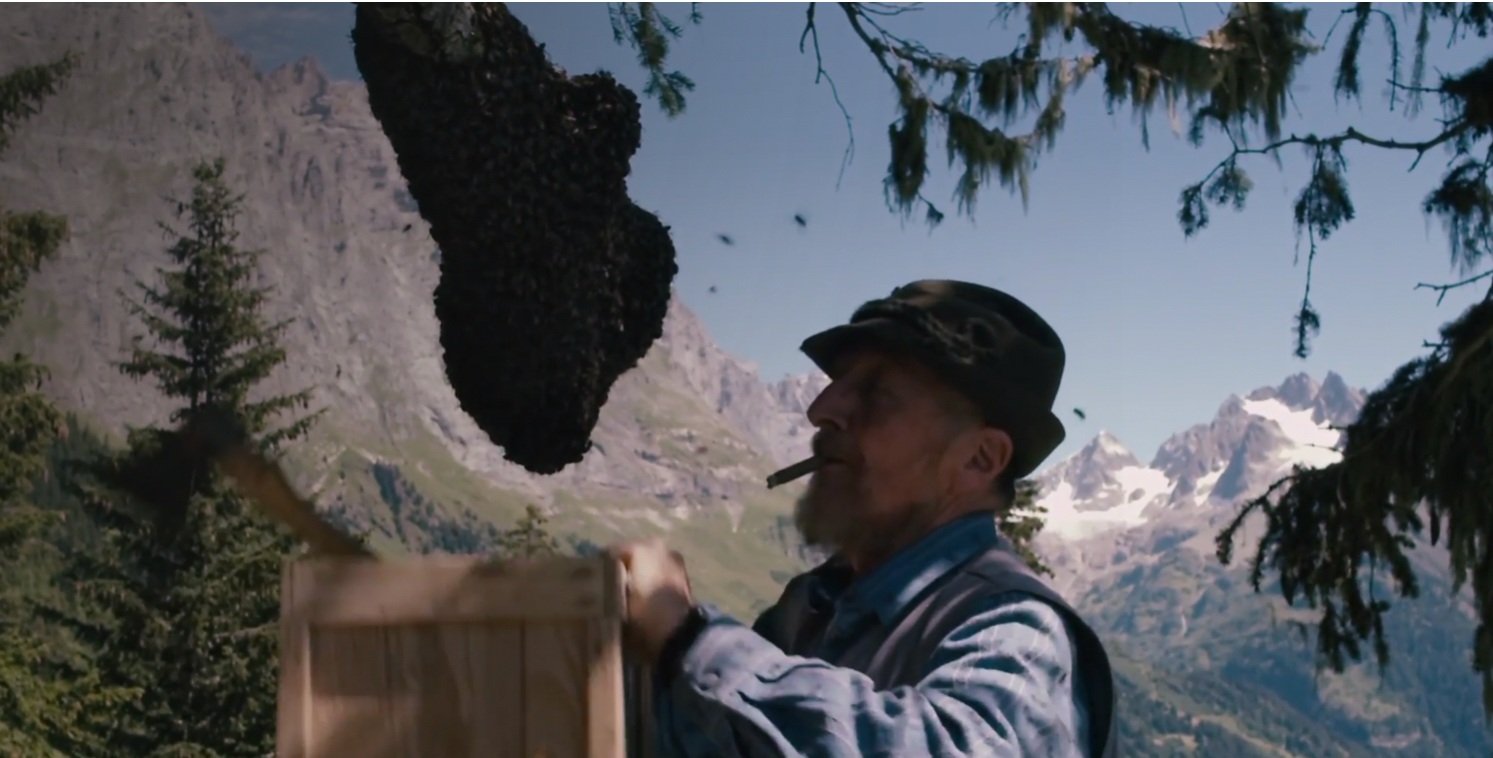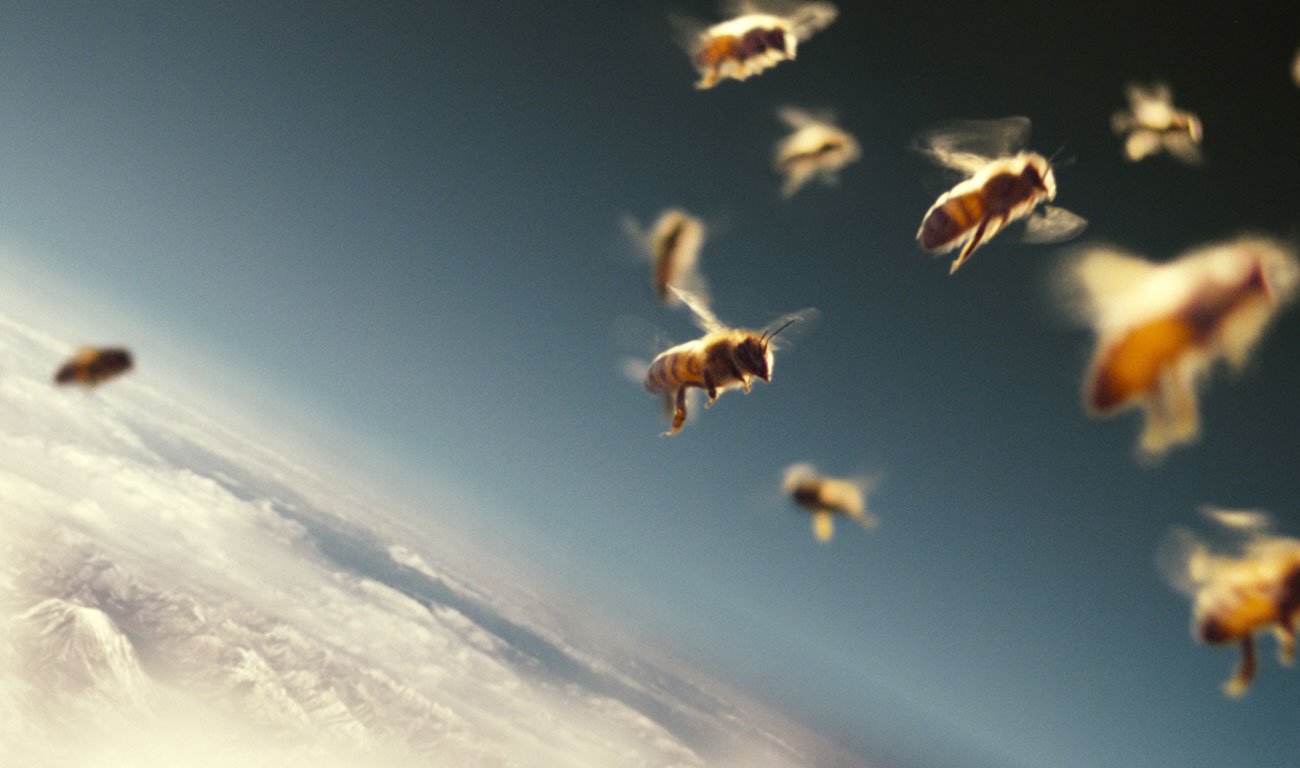Enchanting Encounters and Capitalist Critiques in More Than Honey
More Than Honey, Markus Imhoof (2012)
The camera reels and circles around a hypnotizing sea of bees, a dazzling mass of ferociously laboring creatures, as More Than Honey opens. Director of photography Jörg Jeshel's entrancing cinematography places the viewer at the microscopic level—inside hives, and into the world of bees. In this opening sequence, the spectator is drawn into a realm typically occluded to the human eye: we come face-to-face with a bustling, hectic, yet strangely organized universe, theatrical lighting and the swerving camera underscoring a sense of magnitude. Here, an intricate and mysterious world is disclosed: one governed by a (swarm) logic beyond our ways of being in the world.
After immersing us in this fascinating creaturely realm, More Than Honey zooms out, attempting to show how this community is facing insurmountable threats—bees are dying all around the globe. While the film's opening sequence lures the spectator's attention, its tone quickly turns elegiac. Colony collapse disorder and a host of other diseases are imperiling the bee stock upon which humankind depends for crop fertilization.
Accompanied by the mournful strings of Peter Scherer, director Markus Imhoof investigates this sudden dying out via a side-by-side comparison. On one hand, Imhoof spotlights Fred Jaggi, a small-scale beekeeper in the Swiss Alps, and a relative of the director. On the other, he introduces us to John Miller, a capitalist from Florida that pushes millions of bees across the US in line with shifts in the season—his bees pollinate orchards nationwide, making honey year-round. Although the differences between these two types of bee-keeping are dramatic, both men see their populations shrinking; they remain united in confusion over the unexplainable death of bees around the globe. Yet they take very different approaches to their business. While Jaggi is portrayed as a purist, rooted in a century-long tradition, Miller is depicted as a pragmatist that cares about money first and bees second. "Can you hear that?" Miller asks us, referring to their zooming, "The sound of money!"
More Than Honey, Markus Imhoof (2012)
This comparison is punctuated by a guiding voice-over narrated by actor John Hurt, and scenes with scientists that inquire into the causes of the bees' disappearance. Although pesticides, monocultures and ultra-large-scale bee-keeping seem inextricable from this problem, the film privileges diagnostic complexity. No individual factor is exclusively responsible for the disappearance, nor does there exist a singular solution apt to tackle this problem.
By juxtaposing a rural purist and a global capitalist, More Than Honey instead implies that the dilemma of bees is entangled with forms of living. Through its comparative nature, the film posits a quasi-Marxist entry into the ecological issue of colony collapse disorder—More Than Honey contrasts a seeming pre-capitalist means of collaboration with a late-capitalist mode of production. However, the film neither romanticizes Jaggi nor advocates for a return to a 'primitive state.' Neither does it demonize the capitalist Miller. Rather, this complex issue begs one to look beyond such clear-cut solutions, and the film dutifully draws the viewer's attention to the fact that a larger whole need be addressed. Although some reviews criticized More Than Honey for not proposing solutions, upon further inspection this precise aspect might be its biggest merit. The film does not offer the spectator the solace or relief of knowing that this issue will be easily resolved by quick technological fixes.
More Than Honey, Markus Imhoof (2012)
In her book Vibrant Matter, contemporary philosopher Jane Bennett argues that amid ecological crisis, what is needed is not merely to conceive of practical corrections to our pollution of this planet. Rather, we must re-conceptualize the way we act in daily life. Bennett elaborates that a fundamentally Western (and Enlightenment) approach to categorizing the world has enabled and justified the exploitation and abuse of our natural environments, and that this system must be re-configured in order for a more caring, horizontal form of relation to emerge. "There will be no greening of the economy… without human dispositions, moods, and cultural ensembles hospitable to these effects" (1). Thus, documentary films must not simply disseminate solutions, but work to shift dispositions—the cognitive and behavioral architecture that undergird the ways we interact with and care for a shared planet.
Shots such as those in More Than Honey's opening sequence harbor such potential. Although the majority of the film is dedicated to sketching out the problem of colony collapse disorder and its causes, the film repeatedly returns to these theatrical macro-shots, characterized by sustained attention to a non-human realm with a logic beyond our individualist and humanist-centered means of knowing the world. Through these dramatic shots we learn, see, and almost feel how bees are individuals that collectively comprise a super-organism. Each bee follows a strict function and in doing so serves as part of a larger entity, much like an organ to a body. More Than Honey evokes how bees are thus also agents on a collective level—together forming an organism that far transcends the capabilities of the individual.
More Than Honey, Markus Imhoof (2012)
Environmental theorist Dipesh Chakrabarty designates the ecological crisis as a crisis of imagination—we, as humans, fail to see ourselves as both biological, singular agents and as geological agents (2). Indeed, humans have become geological agents insofar as we have propagated populations and introduced technologies at a scale capable of impacting the planet as such. Seeing ourselves as geological agents is to also attribute to ourselves a world-moving power that transcends the level of the individual, even of the nation. The same way that bees can only create and sustain impressive honey-producing ecologies collectively (aided by swarm logic), so too does mankind produce effects that emerge through our historically and technologically mediated modes of co-existence. Chakrabarty contends that only when we overcome this crisis of imagination—when we start collectively conceiving of ourselves on a geological level—will it become possible to address the challenges posed by the Anthropocene.
By alternating between human bee-keeping perspectives and theatrical macro-footage of the creatures themselves, More Than Honey attunes our perception to a different form of sentience, an alternative way of living together. In these shots, the bees are not depicted as inferior, victimized animals—rather, through spectacular and stylized framings, they gain an alluring alterity. They possess a mode of consciousness beyond our ways of relating to the world, challenging the limits of our imagination and thus addressing the ecological imperative as Chakrabarty has defined it.
More Than Honey, Markus Imhoof (2012)





